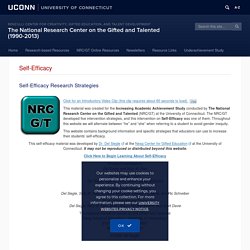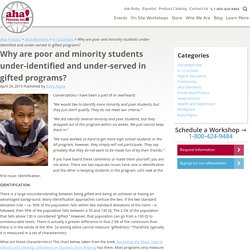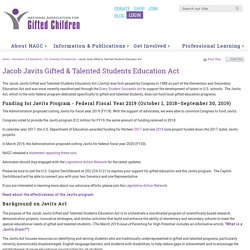

Gifted Strategies for Boys & Girls. Nurturing Gifted Girls PHP Dec17. Gifted Girls to Gifted Women Lori 2 1. The National Research Center on the Gifted and Talented (1990-2013) Click for an Introductory Video Clip (this clip requires about 60 seconds to load)..mpg This material was created for the Increasing Academic Achievement Study conducted by The National Research Center on the Gifted and Talented (NRC/GT) at the University of Connecticut.

The NRC/GT developed five intervention strategies, and this intervention on Self-Efficacy was one of them. Throughout this website we will alternate between “he” and “she” when referring to a student to avoid gender inequity. This website contains background information and specific strategies that educators can use to increase their students’ self-efficacy. This self-efficacy material was developed by Dr. Click Here to Begin Learning About Self-Efficacy Principal InvestigatorsDel Siegle and Sally M. Study Design TeamDel Siegle, Sally M. Intervention Development TeamDel Siegle, Sally M. Study Implementation TeamDel Siegle, Sally M. . © 2000 Del Siegle. Gifted Challenges: How to help your underachieving gifted child. Any child who struggles in school is a challenge and a heartbreak for parents.

But when gifted children veer off course, it can be especially troubling. We know what they are capable of, yet watch helplessly as they squander their talents and potential. Understand why your child is underachieving Underachievement springs from a variety of sources. You can't solve the problem without understanding its cause. In other words, what role does the school play in either unwittingly encouraging - or hopefully correcting - the problem of underachievement among gifted students? If you want to explore how to address - or prevent - school-based underachievement, consider the following: 1. Gifted underachievement can be overt or masked. Recognizing how your child's underachievement is manifest within the school is a first step toward identifying where to address the problem. 2.
The school milieu imposes certain demands that influence each child's reaction to learning. When students value the. Gifted Challenges: What causes gifted underachievement? Why does your gifted child struggle in school?

Your child, once curious, energetic, overjoyed to learn, now has little interest in academics. As a parent, you stand by helplessly, saddened as you watch the spark disappear. Gifted Challenges: Who is the gifted underachiever? Four types of underachievement in gifted children. There is a pervasive myth that all gifted people are high achievers.But many are not.

Most young gifted children are a ball of energy, full of life, curious, intense, and driven. Then reality sets in. They confront the limitations of school, peer pressure, others' expectations and their own fears, and some scale back their drive. Their intrinsic love of learning seems to vanish overnight. Underachievement may develop gradually, with less effort expended on homework, tests or projects. Why students in poverty are under-identified in gifted programs : aha! Process.
April 24, 2015 Published by Ruby Payne Conversations I have been a part of or overheard: “We would like to identify more minority and poor students, but they just don’t qualify.

They do not meet our criteria.” “We did identify several minority and poor students, but they dropped out of the program within six weeks. We just cannot keep them in.” “We have worked so hard to get more high school students in the AP program; however, they simply will not participate. If you have heard these comments or made them yourself, you are not alone. Narrowing the gifted gap for disadvantaged students. MeetingTheNeeds. Gifted programming for poor or minority urban students: Issues and lessons learned. Joseph Renzulli - What is Giftedness? Chapter1 pdf. Jacob Javits Gifted & Talented Students Education Act. The Jacob Javits Gifted and Talented Students Education Act (Javits) was first passed by Congress in 1988 as part of the Elementary and Secondary Education Act and was most recently reauthorized through the Every Student Succeeds Act to support the development of talent in U.S. schools.

The Javits Act, which is the only federal program dedicated specifically to gifted and talented students, does not fund local gifted education programs. Funding for Javits Program - Federal Fiscal Year 2019 (October 1, 2018–September 30, 2019) The Administration proposed cutting Javits for fiscal year 2019 (FY19). With the support of advocates, we were able to convince Congress to fund Javits. Congress voted to provide the Javits program $12 million for FY19, the same amount of funding received in 2018. In calendar year 2017, the U.S. In March 2019, the Administration proposed cutting Javits for federal fiscal year 2020 (FY20). NAGC released a statement opposing these cuts.
Please be sure to call the U.S. Gifted TA manual 1. 10 Social & Emotional Needs of the Gifted. SENG - Supporting Emotional Needs of the Gifted. Gifted Children and Language Development. One characteristic of gifted children is advanced language ability, which means these children reach developmental milestones relating to language earlier than developmental charts would indicate. This means that gifted children tend to talk earlier, have larger vocabularies, and use longer sentences than non-gifted children. How can parents tell if their child's language development is advanced?
A first step is to look at typical language developmental milestones. A second step is to look at what advanced language development is. Language Developmental Milestones Here is what to expect at different ages from infancy until school-age: Makes cooing and gurgling sounds Babbles and makes sing-song sounds Says eight to 10 words others can understandHas a vocabulary of about five to 40 words, mostly nounsRepeats words heard in conversationUses “hi,” “bye,” and “please” when reminded Has a vocabulary of about 1,500 to 2,500 wordsUses sentences of five or more words Early Talking Advanced Vocabulary.
Table of Developmental Milestones Contrasting Normal Children With Gifted Children at 30% Advancement. Gifted Children and Language Development. Traits of Giftedness.